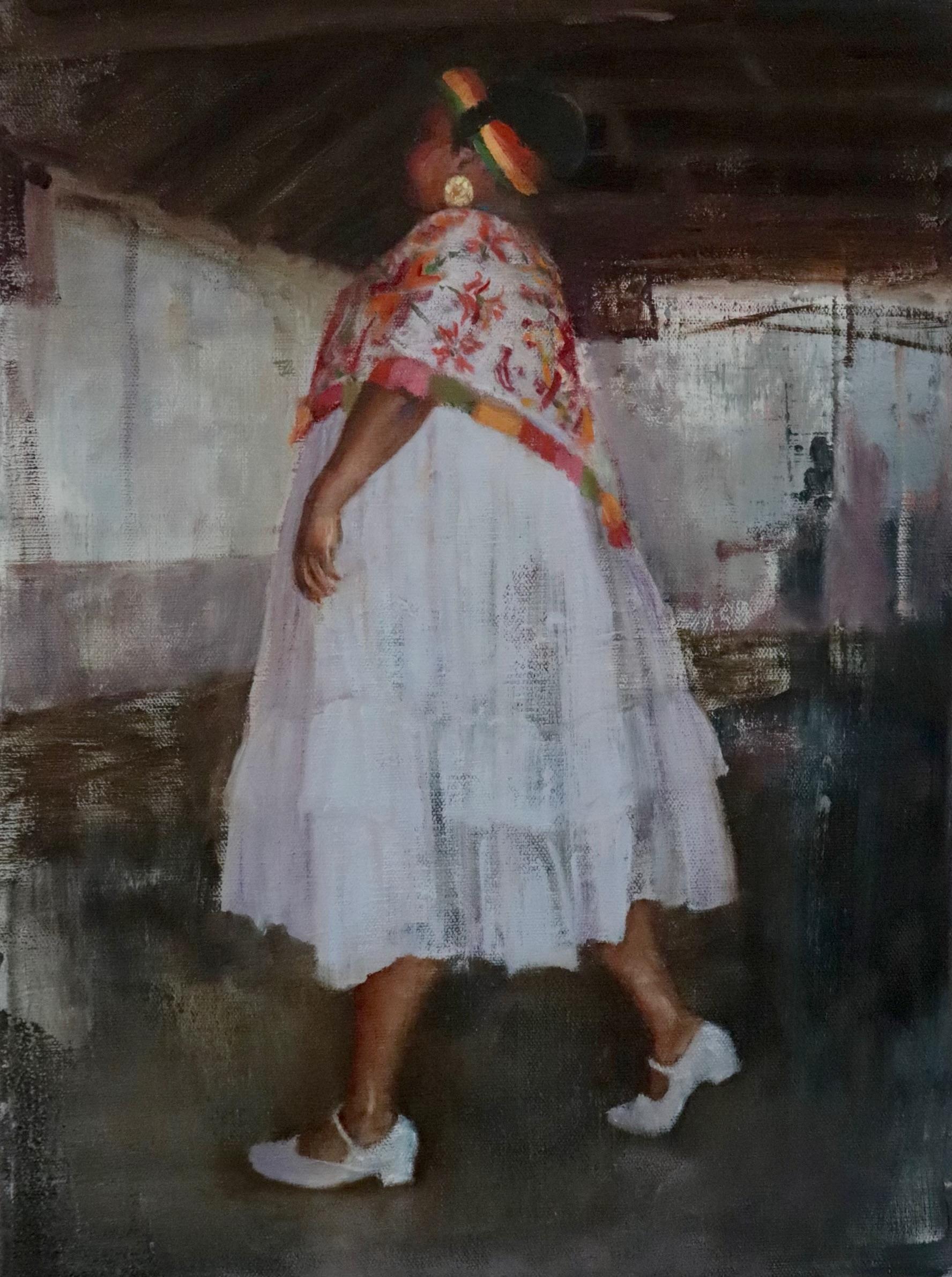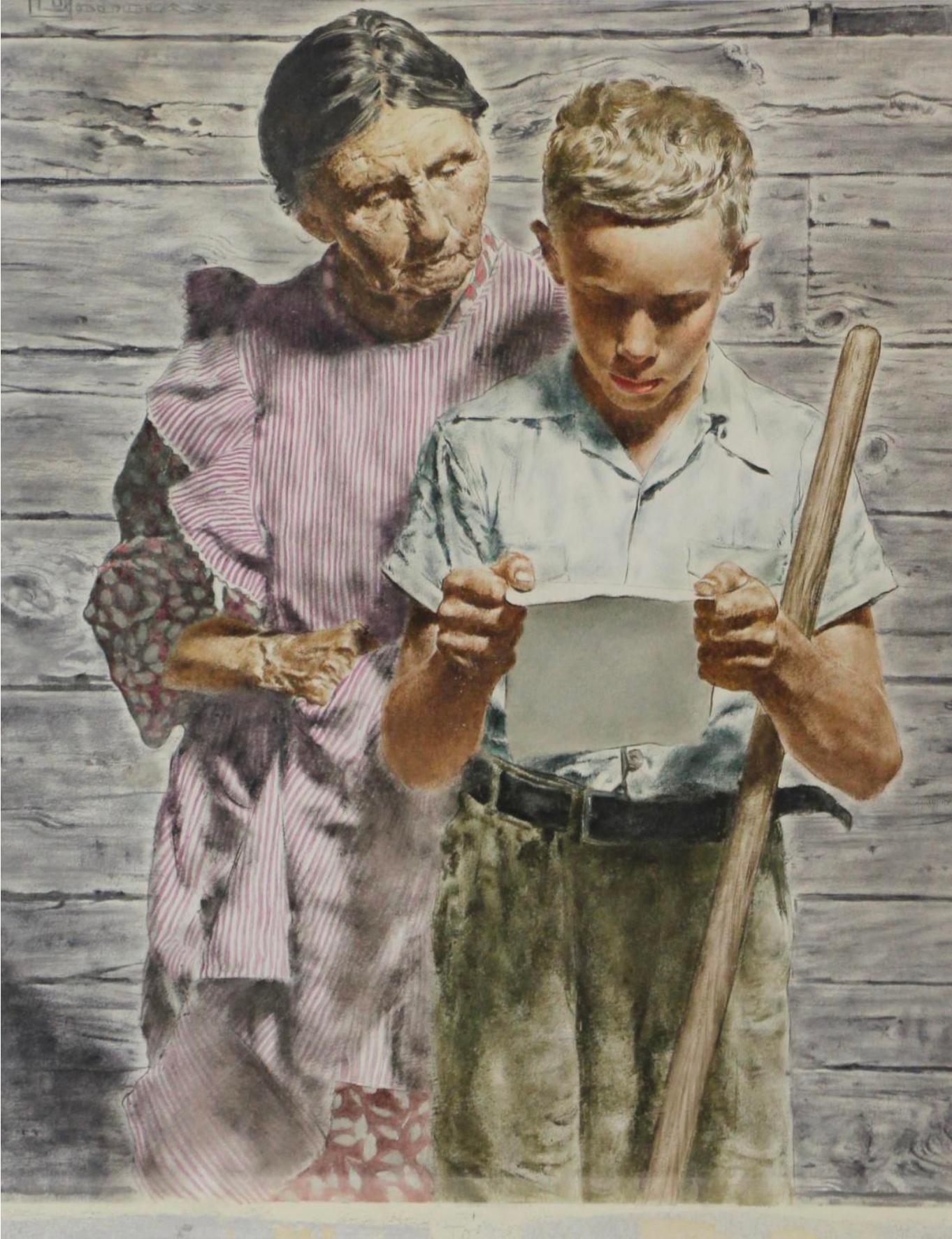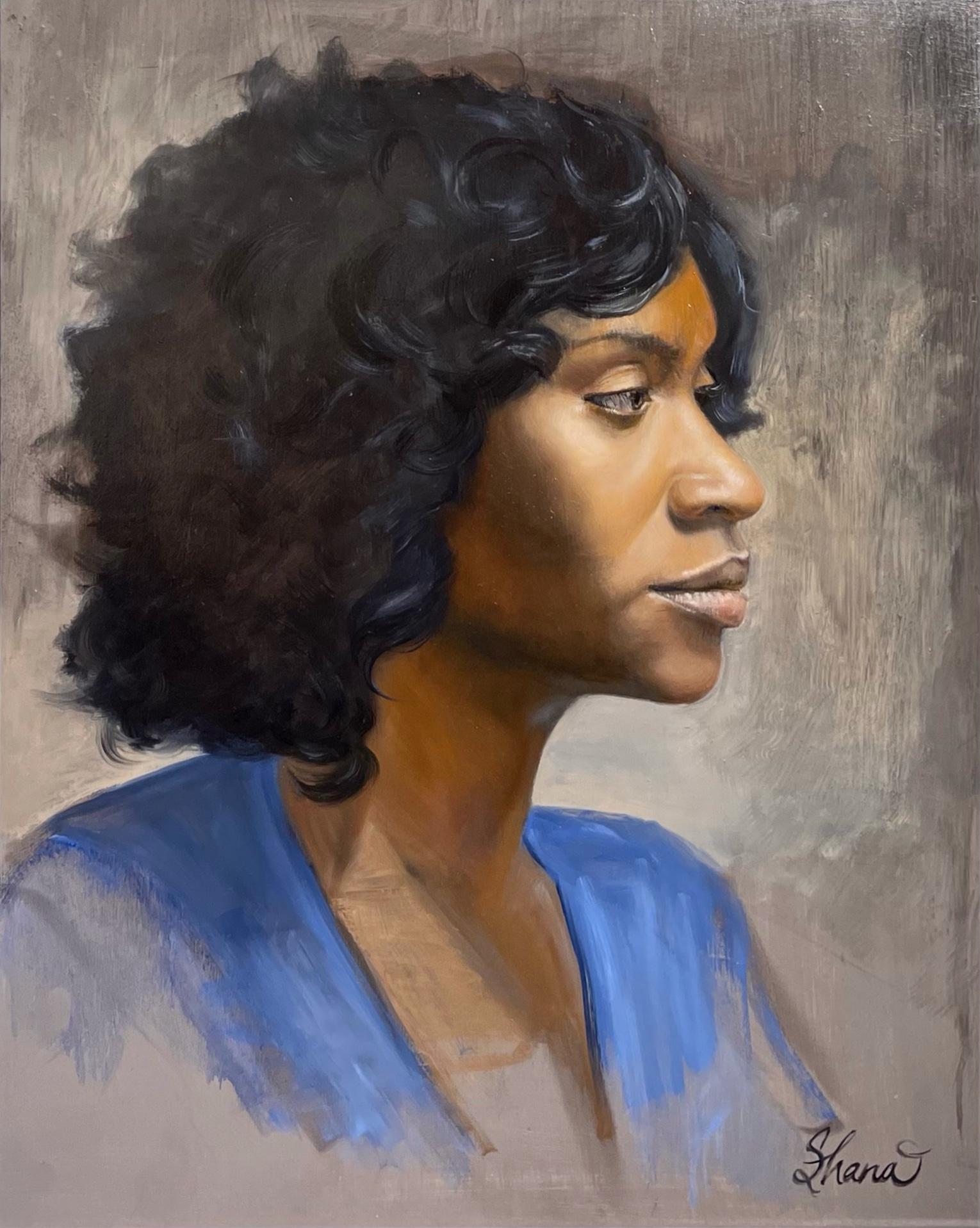Items Similar to 19th Century Oil Painting Portrait of a Muse
Want more images or videos?
Request additional images or videos from the seller
1 of 11
John Opie19th Century Oil Painting Portrait of a Musecirca 1802
circa 1802
About the Item
John Opie RA (1761-1807, English)
c. 1802
Oil on canvas
Canvas dimensions 36 x 32 inches
Framed dimensions 46.5 x 43.25 inches
Original gilded period frame.
John Opie was a Cornish historical and portrait painter. He painted many great men and women of his day, including members of the British Royal Family, and others who were most notable in the artistic and literary professions.
This beautiful, ethereal sitter would have been painted in the later years of Opie's career after he developed his technique and his study of English literature. Opie's interests in Shakespearean plays, historical and mythological subjects can clearly be seen in this charming depiction of a muse who looks out at the viewer with a dream-like gaze. The contrasting dark background and the sitter's rich auburn hair against her porcelain skin, rougued cheeks and red lips on a elfin-like heart shape face, captivate the viewer's intimate attention.
Opie was born in Harmony Cottage, Trevellas, between St Agnes and Perranporth in Cornwall, UK. He was the youngest of the five children of Edward Opie, a master carpenter, and his wife Mary (née Tonkin). He showed a precocious talent for drawing and mathematics, and by the age of twelve he had mastered Euclid and opened an evening school for poor children where he taught reading, writing and arithmetic. His father, however, did not encourage his abilities, and apprenticed him to his own trade of carpentry.
Opie's artistic abilities eventually came to the attention of local physician and satirist, Dr John Wolcot (Peter Pindar), who visited him at the sawmill where he was working in 1775. Recognising a great talent, Wolcot became Opie's mentor, buying him out of his apprenticeship and insisting that he come to live at his home in Truro. Wolcot provided invaluable encouragement, advice, tuition and practical help in the advancement of his early career, including obtaining many commissions for work.
In 1781, having gained considerable experience as a portraitist travelling around Cornwall, Opie moved to London with Wolcot. There they lived together, having entered into a formal profit-sharing agreement. Although Opie had received a considerable artistic education from Wolcot, the doctor chose to present him as a self-taught prodigy; a portrait of a boy shown at the Society of Artists the previous year, had been described in the catalogue as "an instance of Genius, not having ever seen a picture." Wolcot introduced the "Cornish wonder" to leading artists, including Sir Joshua Reynolds, who was to compare him to Caravaggio and Velazquez, and to prospective patrons. The business arrangement with Wolcot lasted for a year, after which Opie informed the doctor that he now wished to go it alone, leading to the estrangement of the two former partners.
Through the influence of a Mrs Boscawen, Wolcot managed to have Opie introduced at the court of King George III. The King purchased one of his pictures and commissioned him to produce a portrait of Mary Delany. He also received commissions to paint the Duke and Duchess of Gloucester, Lady Salisbury, Lady Charlotte Talbot, Lady Harcourt and other ladies of the court. Opie's residence at "Orange Court", Castle Street, Leicester Fields, was said to be "crowded with rank and fashion every day" and he was the talk of the town. In 1782 he first exhibited at the Royal Academy and in December of that year was married to Mary Bunn. The match, however, proved to be an unhappy one and they were eventually divorced in 1796 after her elopement.
Opie's work, after an initial burst of popularity, rapidly fell out of fashion. In response to this he began to work on improving his technique, while at the same time seeking to supplement his early education by the study of Latin, French and English literature, and to polish his provincial manners by mixing in cultivated and learned circles. In 1786 he exhibited his first important historical subject, the Assassination of James I, and in the following year the Murder of Rizzio, a work whose merit was recognised by his immediate election as associate of the Royal Academy, of which he became a full member in 1788. He painted five subjects for John Boydell's Shakespeare Gallery; and until his death, his practice alternated between portraiture and historical work. In May 1798 he married Amelia Alderson whom he had met at a party in Norwich, having gone to Norfolk to carry out some commissions for Thomas Coke at Holkham Hall. They lived at 8 Berners Street, where Opie had moved in 1791.
Opie painted many notable men and women including Mary Wollstonecraft, Samuel Johnson, Francesco Bartolozzi, John Bannister, Joseph Munden, Charles James Fox, William Betty, Edmund Burke, John Crome, James Northcote, Henry Fuseli, Thomas Girtin, Robert Southey, Samuel Parr, Elizabeth Inchbald and Mary Shelley; 508 portraits in all, mostly in oil, and 252 other pictures.
- Creator:John Opie (1761 - 1807)
- Creation Year:circa 1802
- Dimensions:Height: 46.5 in (118.11 cm)Width: 43.25 in (109.86 cm)
- Medium:
- Period:
- Condition:
- Gallery Location:London, GB
- Reference Number:1stDibs: LU67335788342
About the Seller
5.0
Vetted Seller
These experienced sellers undergo a comprehensive evaluation by our team of in-house experts.
Established in 1990
1stDibs seller since 2017
40 sales on 1stDibs
Typical response time: 4 hours
- ShippingRetrieving quote...Ships From: London, United Kingdom
- Return PolicyA return for this item may be initiated within 1 day of delivery.
More From This SellerView All
- Lady Dormore - A 16th Century Portrait of a key member of Shakespeare's EnglandLocated in London, GBLady Dormer, Mary Browne c. 1592 oil on panel 35 x 29 inches, unframed; 41 x 34.75 inches, inc. frame Inscribed 'Lady Dormore' Mary married Henry Wriothesley, 2nd Earl of Southampton who gave birth to Henry Wriothesley, 3rd Earl of Southampton - one of the great figures in Shakespears"s circle and founder of the Virginia company, developers of Virginia USA. Henry Wriothesley, born 6 October 1573 at Cowdray House, Sussex, was the only son of Henry Wriothesley, 2nd Earl of Southampton, by Mary Browne, the only daughter of Anthony Browne, 1st Viscount Montague, and his first wife, Jane Radcliffe.[5] He had two sisters, Jane, who died before 1573, and Mary (c. 1567 – 1607), who in June 1585 married Thomas Arundell, 1st Baron Arundell of Wardour.[6] After his father's death, Southampton's mother married firstly, on 2 May 1595, as his second wife, Sir Thomas Heneage (d. 17 October 1595), Vice-Chamberlain of the Household, and secondly, between 5 November 1598 and 31 January 1599, Sir William Hervey. She died in November 1607.[7] Early life When his father died on 4 October 1581 Southampton inherited the earldom and landed income valued at £1097 6s per annum. His wardship and marriage were sold by the Queen to her kinsman, Charles, Lord Howard of Effingham, for £1000. According to Akrigg, Howard then "entered into some further agreement, of which no documentation can now be found, which transferred to Lord Burghley personally the custody and marriage of the young Earl, but left Howard holding his lands", and late in 1581 or early in 1582 Southampton, then eight years of age, came to live at Cecil House in the Strand.[8] In October 1585, at age twelve, Southampton entered St John's College, Cambridge,[9] graduating M.A. on 6 June 1589.[10] His name was entered at the Gray's Inn legal society before he left the university, and he was admitted on 29 February 1588.[11] On Southampton's 16th birthday, 6 October 1589, Lord Burghley noted Southampton's age in his diary, and by 1590 Burghley was negotiating with Southampton's grandfather, Anthony Browne, 1st Viscount Montague, and Southampton's mother, Mary, for a marriage between Southampton and Lord Burghley's eldest granddaughter, Elizabeth Vere, daughter of Burghley's daughter, Anne Cecil, and Edward de Vere...Category
16th Century Old Masters Figurative Paintings
MaterialsOil
- 18th C. Portrait of the 4th Earl of Sandwich a View of Constantinople BeyondLocated in London, GBJohn Montagu, 4th Earl of Sandwich (13 November 1718 – 30 April 1792) Attributed to George Knapton (1698-1778) Dressed in the Turkish manner, stand...Category
18th Century Old Masters Figurative Paintings
MaterialsOil
- 17th Century Oil Painting Portrait of a Young English BoyBy Gerard SoestLocated in London, GBGerard SOEST (1600 - 1681) Portrait of a Young Boy oil on canvas 35.5 x 30.5 inches inc. frame Gerard Soest (circa 1600 – 11 February 1681), also known as Gerald Soest, was a portra...Category
17th Century Old Masters Portrait Paintings
MaterialsOil
- Double Portrait Oil Painting Brothers George, 2nd Duke Buckingham & Lord FrancisBy (After) Anthony Van DyckLocated in London, GBAftrer Anthony VAN DYCK - maybe Studio (1599, Antwerp – 1641, London) Flemish Double Portrait of George Villiers, 2nd Duke of Buckingham (1628-1687) & Lord Francis Villiers (1629-1648) Oil on Canvas 170 x 147 cm Anthony Van Dyck (1599-1641) No painter has done more to define an era than Anthony van Dyck. He spent only seven and a half years of his short life (1599- 1641) in England. He grew up in Antwerp, where his precocious talent was recognised by Peter Paul Rubens, the greatest painter of his age. He worked in Rubens’s studio and imitated his style as a religious artist, painting biblical scenes redolent of the lush piety of the counter-reformation. But soon he was on the move. In 1620, he visited London for a few months, long enough to paint a history picture, The Continence of Scipio, for the royal favourite, George Villiers, Marquess of Buckingham, and a portrait of his other English patron, the great art collector, Thomas Howard, 2nd Earl of Arundel. After a stint in Italy, making imposing portraits of the wealthy aristocracy and sketching and copying works by Titian, he returned to the Spanish Netherlands in 1627, becoming court artist to Archduchess Isabella before departing for The Hague in 1631 to paint the Dutch ruler Frederick Henry, Prince of Orange. Charles I’s invitation in 1632 led Van Dyck back to London where he was knighted, paid an annual salary of £200 and installed in a house in Blackfriars with a special jetty at which the royal barge might tie up when the King was visiting his studio. By this time Van Dyck was recognised as the leading court painter in Europe, with Velazquez at the court of Philip IV of Spain his only rival. He also excelled as a superbly observant painter of children and dogs. Van Dyck’s notoriety in depicting children led to the introduction of groups of children without their parents as a new genre into English painting (amongst other new genres). For the next 300 years, Van Dyck was the major influence on English portraiture. Nearly all the great 18th Century portraitists, from Pompeo Batoni and Allan Ramsay to Thomas Gainsborough and Joshua Reynolds, copied Van Dyck’s costumes, poses and compositions. George Duke of Buckingham & his brother Francis Villiers Painted in 1635, this double portrait was originally commissioned by Charles I, who raised the two brothers after their father, George Villiers, was assassinated in 1628. Together with their sister, Lady Mary Villiers, they enjoyed the King’s favour absolutely. Francis whose absolute ‘inimitable handsomeness’ was noted by Marvell (who was killed in a skirmish near Kingston upon Thames). The young duke who commanded a regiment of horse at the Battle of Worcester, remained closely associated with Charles II, held a number of high offices after the Restoration and was one of the most cynical and brilliant members of the King’s entourage, immortalised as ‘Zimri’ in Dryden’s Absalom and Achitopbel. As a young man he had sold his father’s great collection of pictures in the Spanish Netherlands, many of them to the Archduke Leopold Willhelm. Painted for Charles I and placed near the portrait of their sister in the Gallery at St James’ Palace. The handling of both costumes is very rich, and the heads are very carefully and sensitively worked. That of the younger boy in particular is more solidly built up than the lower part of the figure. A preparatory drawing for the younger boy is in the British Museum. There are copies at, e.g., Highclere Castle...Category
17th Century Old Masters Portrait Paintings
MaterialsOil
- 17th Century Italian Oil Painting Portrait of Music Prodigy Girolamo FrescobaldiLocated in London, GBPortrait of Girolamo Frescobaldi (1583-1643) Attributed to Antiveduto Della Grammatica (1571-1626) Oil on Canvas 1605-1609 Framed in a Nineteenth Century gild and composite frame 44....Category
Early 17th Century Baroque Figurative Paintings
MaterialsOil
- Stunning 17th Century Oil Painting - Study of a Head of a ManBy Anthony van DyckLocated in London, GBStudio of Sir Anthony Van Dyck (1599-1641, Flemish) Study of a Head of Man Circa 1627-32, Van Dyck’s second Antwerp period Oil on paper, laid down on canvas Dimensions 15 x 14 inches...Category
17th Century Old Masters Portrait Paintings
MaterialsOil
You May Also Like
- Nicholas V. Sanchez - La Brisa, Painting 2021Located in Greenwich, CToil on canvas 48” H x 36” W Nicolas V. Sanchez received his BFA from Kendall College of Art and Design in Grand Rapids, MI and his MFA from the New York Academy of Art. While at the...Category
2010s Contemporary Figurative Paintings
MaterialsCanvas, Oil
- Nicholas V. Sanchez - Veracruz Dancer, Painting 2021Located in Greenwich, CToil on canvas 30” H x 40” W Nicolas V. Sanchez received his BFA from Kendall College of Art and Design in Grand Rapids, MI and his MFA from the New York Academy of Art. While at the...Category
2010s Contemporary Figurative Paintings
MaterialsCanvas, Oil
- Nicholas V. Sanchez - Ballerina de Sol, Painting 2021Located in Greenwich, CToil on canvas 16” H x 12” W Nicolas V. Sanchez received his BFA from Kendall College of Art and Design in Grand Rapids, MI and his MFA from the New York Academy of Art. While at th...Category
2010s Contemporary Figurative Paintings
MaterialsCanvas, Oil
- Grand Mother and Grand Son Read Emotional LetterBy Spencer Douglass CrockwellLocated in Miami, FLCrockwell is as good as Rockwell. Many would agree with that statement including the editors of the Saturday Evening Post in which both artists were frequent contributors. In fact, ...Category
1950s American Realist Figurative Paintings
MaterialsMixed Media, Oil
- "Wrung, " Oil paintingBy Jaclyn AldereteLocated in Denver, COJaclyn Alderete's (US based) "Wrung" is an original, handmade oil painting that depicts lone woman in blue flowing skirt holding her hands over her fac...Category
2010s Impressionist Portrait Paintings
MaterialsOil, Board
- "Untitled, " Oil PaintingLocated in Denver, COShana Levenson's "Untitled" is an original, handmade oil painting that depicts a close up portrait of a female model. This is a secondary market work ...Category
2010s Realist Portrait Paintings
MaterialsOil, Panel
Recently Viewed
View AllMore Ways To Browse
Uk Portrait
19th Century Original Oil Paintings
Polish 19th Century Art
Muse Two
Early 19th Century English Portrait
19th Century Lady Painting
19th Century Painting Of A Lady
Gilded Age Paintings
Portrait On Porcelain
Early 19th Century Portrait French
Drawings Of Men Faces
King Of Hearts
St George 19th
19th Century Portraits Of Men
French Porcelain Portrait
Portrait Doctor
Portrait Of A Doctor
Talk Of The Town





